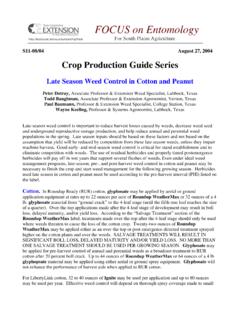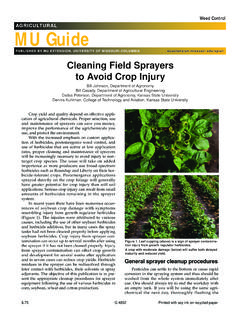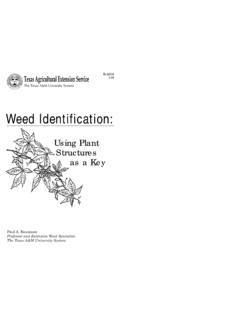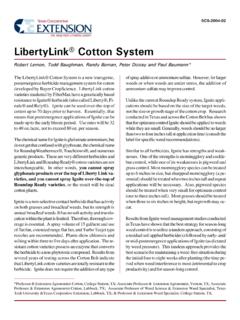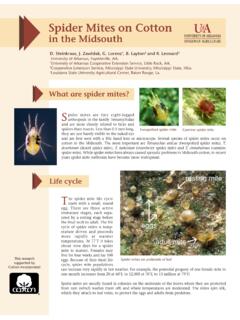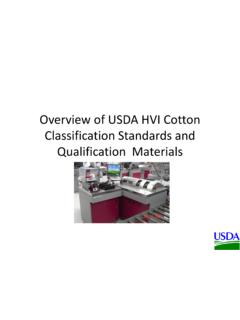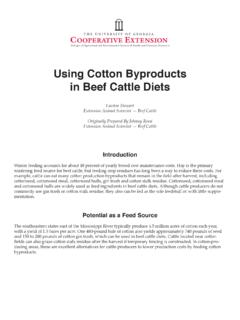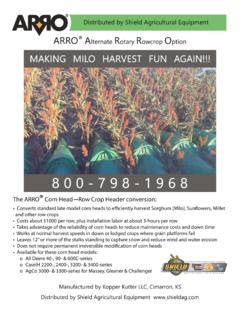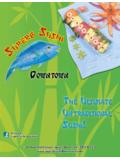Transcription of Crop Production Guide Series - cotton.tamu.edu
1 S5-05/04 May 14, 2004 Crop Production Guide Series Successful Weed Management Systems Include the Use of Dinitroaniline Herbicides Peter Dotray, Associate Professor & Extension Weed Specialist, Lubbock, Texas Todd Baughman, Associate Professor & Extension Agronomist, Vernon, Texas Paul Baumann, Professor & Extension Weed Specialist, College Station, Texas Wayne Keeling, Professor & Systems Agronomist, Lubbock, Texas The use of Prowl (pendimethalin) or Treflan (trifluralin) is the first step towards successful weed management programs in cotton while Prowl, Treflan, and Sonalan are the backbone for successful weed management in peanuts.
2 The strength of these dinitroaniline (DNA) herbicides is annual grass control (barnyardgrass, crabgrass, foxtails, panicums, etc.) and control of small-seeded broadleaf weeds such as Palmer amaranth (carelessweed and other pigweed species), Russian thistle (tumbleweed), and kochia (ironweed). Most larger-seeded broadleaf weeds, like annual morningglories, cocklebur, and sunflowers, and perennial weeds are not controlled by these herbicides. The rate of each DNA herbicide is dependent on soil type.
3 The sandier the soil, the lower the recommended rate. High rates in sandy soil may injure crops. If soil conditions are dry and large clods are present during mechanical incorporation, herbicide performance will be less effective. Keep in mind that when Treflan was first used over 30 years ago, farmers were diligent with two-pass incorporation prior to bedding and planting. This resulted in thorough mixing of the herbicide and excellent weed control. In recent years many farmers have cut back on incorporation to save time and money.
4 Some have still achieved adequate weed control while others have observed that poor incorporation caused herbicide failures. With the good rains so far in 2004, conditions have been ideal to apply preplant incorporated herbicides. In cotton, Prowl EC rates range from to pints per acre. Rates for Treflan and other trifluralin products (formulated at 4 pounds per gallon) range from 1/2 to 1 pint per acre for sandy soils, and up to 2 pints per acre on other soils. In peanuts, Prowl may be used at to pints, Treflan at 1/2 to 1 pint, and Solanan HFP at 11/2 to 2 pints on coarse soils and 2 to 2 1/2 pints on medium soils.
5 The DNA herbicides may be incorporated by mechanical means or by irrigation. Incorporation methods vary widely across the High Plains and state. A double-pass method of incorporation is recommended on most labels with the second incorporation made at an angle to the first incorporation, but a single-pass is most commonly used. Mechanical implements used to incorporate these herbicides include a springtooth harrow, a disk, a double or single stalkcutter, and a rolling cultivator to name a few. The better the implement mixes and uniformly distributes the herbicide in the upper 1- to 2-inches of soil, the better the weed control.
6 Treflan should be incorporated within 24 hours after application. Sonalan and Prowl must be incorporated 48 hours and 7 days after application, respectively, but the sooner the better. Prowl and Sonalan may be surface applied and then incorporated by rainfall or irrigation. Three-quarters to one-inch of irrigation is necessary to incorporate (activate) these herbicides. Both Prowl and Treflan may be chemigated into the soil. These applications may not be the best way to incorporate Prowl, Sonalan, or Treflan, but may be the only way to use these herbicides in a reduced tillage or no-tillage crop Production system.
7 When surface applications followed by irrigation or chemigation methods are used, herbicide rates are generally higher when compared to mechanically incorporated methods. Research conducted at the AG-CARES farm north of Lamesa by researchers with the Texas Agricultural Experiment Station suggested that Prowl provided more consistent weed control when compared to Treflan when surface applied and watered in, but Treflan performed better than Prowl when chemigated. Always carefully read and follow label recommendations.
8 Prowl H20 will be available in 2004. One gallon of Prowl H20 contains pounds of pendimethalin formulated as an aqueous capsule suspension. Since it formulated at a higher concentration than Prowl EC, less product is needed on a per acre basis in general. In cotton, Prowl H20 may be applied in conventional, minimum, stale seedbed, or no-till systems as a preplant surface, preplant incorporated, pre-emergence, or layby application. Use rates vary from 2 to 4 pints per acre depending on soil texture and tillage system.
9 In peanuts, Prowl H20 may be applied at pints per acre preplant incorporated or pre-emergence under overhead irrigation. Prowl H2O can be chemigated in both cotton and peanuts. Crop Production Guide Series , a supplement to Focus on Entomology newsletter, is published by Texas Cooperative Extension Route 3, Box 213AA Lubbock, TX 79403 For more information call or e-mail: 806-746-6101 or Editor: James F. Leser Associate Editor & Graphic Designer: Michelle Coffman Educational programs conducted by Texas Cooperative Extension serve people of all ages regardless of socio-economic level, race, color, sex, religion, handicap or national origin.
10 References to commercial products or trade names is made with the understanding that no discrimination is intended and no endorsement by Texas Cooperative Extension is implied.
